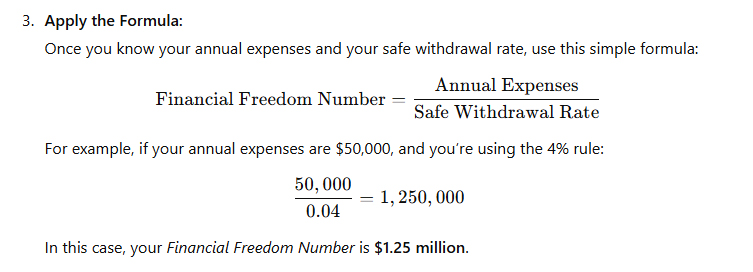How to Calculate Your Financial Freedom Number and Why It Matters

Achieving financial freedom is a goal many aspire to, but few fully understand what it truly means. It’s more than just having enough money to pay your bills or live comfortably—it’s about having the resources to live life on your terms without being dependent on a paycheck. But before you can reach this coveted status, you need to know your Financial Freedom Number. This figure represents the amount of money you need to cover your living expenses indefinitely, without having to work unless you choose to.
What is a Financial Freedom Number?
Your Financial Freedom Number is essentially the amount of money you need invested or saved to generate enough passive income to cover your lifestyle expenses. This could come from dividends, rental income, interest, or other investment returns. When you hit this number, you’re financially independent—you can retire early, pursue passion projects, or travel the world without worrying about where your next paycheck will come from.
Why Your Financial Freedom Number Matters
Knowing your Financial Freedom Number is like having a roadmap for your financial journey. Without it, you might be saving blindly, unsure if you’re on track to meet your long-term goals. Here’s why it matters:
- Clarity and Direction: It gives you a clear target to aim for, making your financial planning more focused.
- Motivation: Seeing how close (or far) you are from your goal can inspire you to make smarter financial decisions, like cutting unnecessary expenses or investing more aggressively.
- Stress Reduction: Understanding your financial position reduces anxiety about the future, giving you peace of mind that you’re prepared for whatever life throws your way.
- Empowerment: Once you know your number, you’re in control. You can decide how much you need to work, how much to invest, and how soon you can achieve financial independence.
How to Calculate Your Financial Freedom Number
Calculating your Financial Freedom Number isn’t as complicated as it sounds. It boils down to understanding your expenses and the returns on your investments. Here’s a step-by-step guide:
- Determine Your Annual Expenses:
Start by calculating how much money you need annually to maintain your desired lifestyle. Include housing, utilities, food, transportation, healthcare, travel, entertainment, and any other recurring costs. Don’t forget to factor in inflation and unexpected expenses like emergencies. - Decide on a Safe Withdrawal Rate:
The Safe Withdrawal Rate (SWR) is the percentage of your investments you can safely withdraw each year without running out of money. A commonly used rule is the 4% Rule, which suggests you can withdraw 4% of your investments annually without depleting your savings.
Apply the Formula:
Once you know your annual expenses and your safe withdrawal rate, use this simple formula:
Once you know your annual expenses and your safe withdrawal rate, use this simple formula:

- Adjust for Your Lifestyle:
If you plan to live a more luxurious lifestyle or expect higher healthcare costs, adjust your annual expenses accordingly. Similarly, if you expect to downsize or live in a more affordable area, your number may be lower.
Factors That Can Affect Your Financial Freedom Number
While the calculation is straightforward, several factors can influence your Financial Freedom Number:
- Inflation: Over time, the cost of living rises. It’s important to factor in an average inflation rate (usually around 2-3% annually) when planning for the future.
- Investment Performance: Your portfolio’s return rate can impact how quickly you reach your goal. Diversify your investments to balance risk and reward.
- Lifestyle Changes: Major life events like marriage, having children, or relocating can alter your expenses significantly.
- Healthcare Costs: Especially as you age, healthcare can become a major expense, so it’s wise to account for these potential costs in your calculations.
Taking the Next Steps Toward Financial Freedom
Once you’ve calculated your Financial Freedom Number, it’s time to put a plan in motion. This might involve:
- Increasing your savings rate by cutting unnecessary expenses or boosting your income.
- Investing wisely to ensure your money grows efficiently over time.
- Monitoring and adjusting your plan as life circumstances change.
Achieving financial freedom isn’t just about hitting a number—it’s about gaining the confidence and flexibility to live life on your terms. By understanding and calculating your Financial Freedom Number, you take a critical step toward securing your financial future and creating the life you’ve always wanted.
